Discover 15 hidden attractions, cool sights, and unusual things to do in Iraq. Don't miss out on these must-see attractions: Citadel of Erbil (Arbil), Kurdish Textile Museum (Arbil) or Republican Palace (Baghdad).
Below, you can find the list of the most amazing places you should visit in Iraq.
Table of Contents
Citadel of Erbil, Arbil
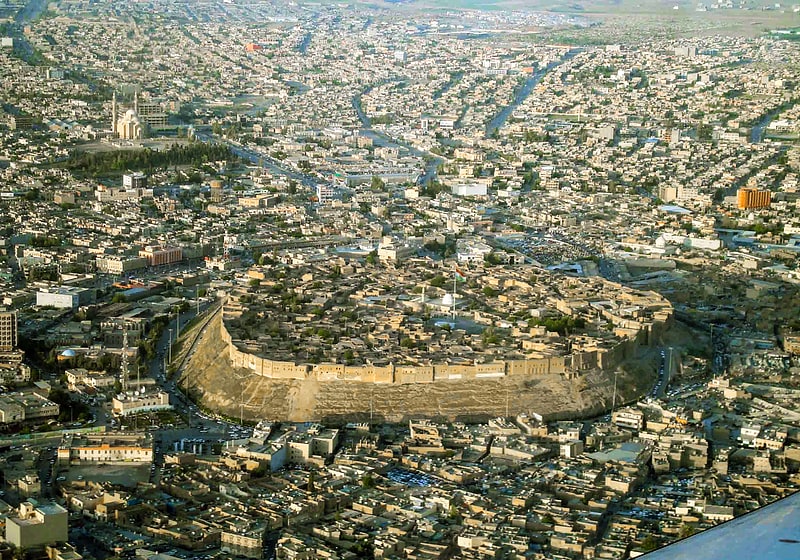
Also known as: قلعة أربيل
Ancient citadel with a mosque and museums. The Erbil Citadel, locally called Qelat is a tell or occupied mound, and the historical city centre of Erbil in the Kurdistan Region of Iraq. The citadel has been inscribed on the World Heritage List since 21 June 2014.
The earliest evidence for occupation of the citadel mound dates to the 5th millennium BC, and possibly earlier. It appears for the first time in historical sources in the Ebla tablets around 2,300 BC, and gained particular importance during the Neo-Assyrian period. During the Sassanian period and the Abbasid Caliphate, Erbil was an important centre for Christianity. After the Mongols captured the citadel in 1258, the importance of Erbil declined. During the 20th century, the urban structure was significantly modified, as a result of which a number of houses and public buildings were destroyed. In 2007, the High Commission for Erbil Citadel Revitalization (HCECR) was established to oversee the restoration of the citadel. In the same year, all inhabitants, except one family, were evicted from the citadel as part of a large restoration project. Since then, archaeological research and restoration works have been carried out at and around the tell by various international teams and in cooperation with local specialists. The government plans to have 50 families live in the citadel once it is renovated.
The buildings on top of the tell stretch over a roughly oval area of 430 by 340 metres (1,410 ft × 1,120 ft) occupying 102,000 square metres (1,100,000 sq ft). The only religious structure that currently survives is the Mulla Afandi Mosque. The mound rises between 25 and 32 metres (82 and 105 ft) from the surrounding plain. When it was fully occupied, the citadel was divided in three districts or mahallas: from east to west the Serai, the Takya and the Topkhana. The Serai was occupied by notable families; the Takya district was named after the homes of dervishes, which are called takyas; and the Topkhana district housed craftsmen and farmers.[1]
Kurdish Textile Museum, Arbil
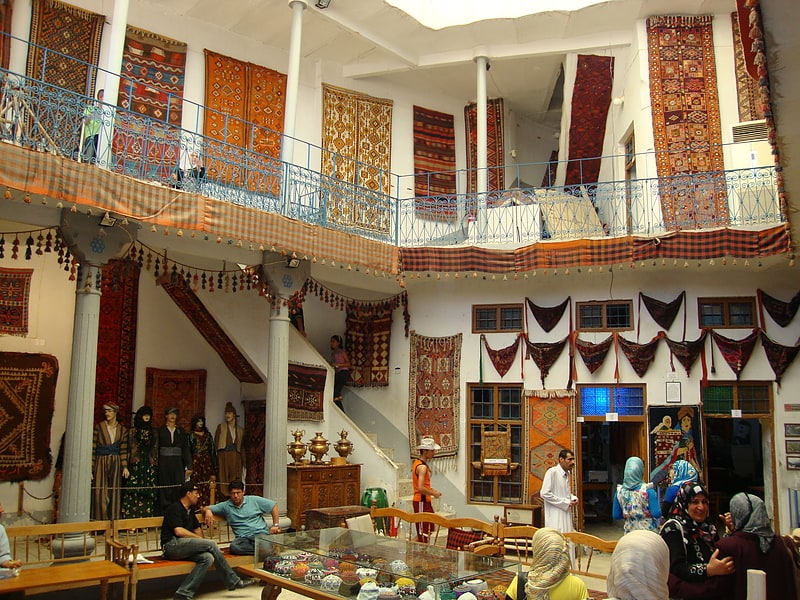
Also known as: متحف المنسوجات الكردية
Museum in Erbil, Iraqi Kurdistan. The Kurdish Textile and Cultural Museum is a museum devoted to textiles produced in Iraqi Kurdistan. It was established in 2004 and is located in a renovated mansion in the southeast quarter of the Citadel of Arbil.[2]
Address: Erbil Citadel, 44001 Erbil
Republican Palace, Baghdad
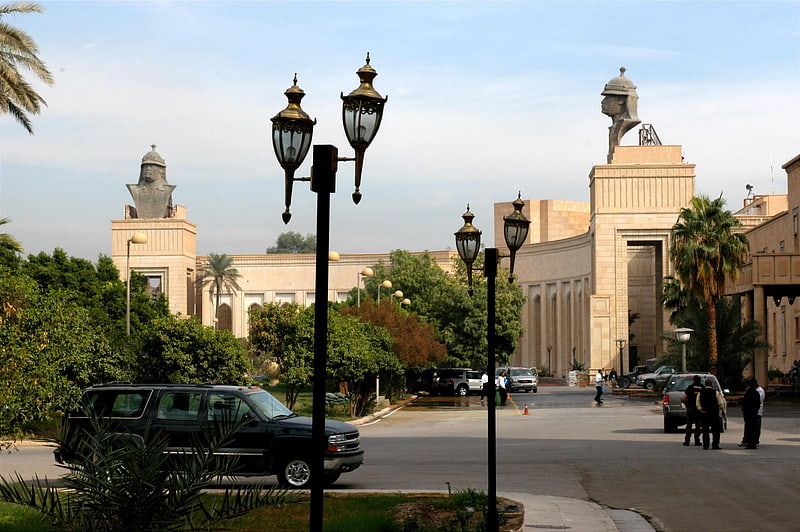
Also known as: القصر الجمهوري
Palace in Baghdad, Iraq. The Republican Palace is a palace in Baghdad, Iraq, constructed on the orders of King Faisal II. It was Saddam Hussein's preferred place to meet visiting heads of state. The United States spared the palace during its shock and awe raid during the 2003 invasion of Iraq, in the belief that it might hold valuable documents. The Green Zone developed around it. The palace itself served as the Multi-National Force – Iraq Headquarters of Coalition troops during the U.S. Occupation of Iraq as well as the primary base of operations for the American diplomatic mission in Iraq until the opening of the new US Embassy in Baghdad in 2009.[3]
Erbil Civilization Museum, Arbil

The Erbil Civilization Museum is an archeological museum which is located within the city of Hawler, the capital of Iraqi Kurdistan. It is the second largest museum in Iraqi Kurdistan, after the Sulaymaniyah Museum in Sulaymaniyah Governorate in terms of contents and collections. It houses artifacts which date back to the pre-historic period to the late Abbasid period.[4]
Al-Kadhimiya Mosque, Baghdad
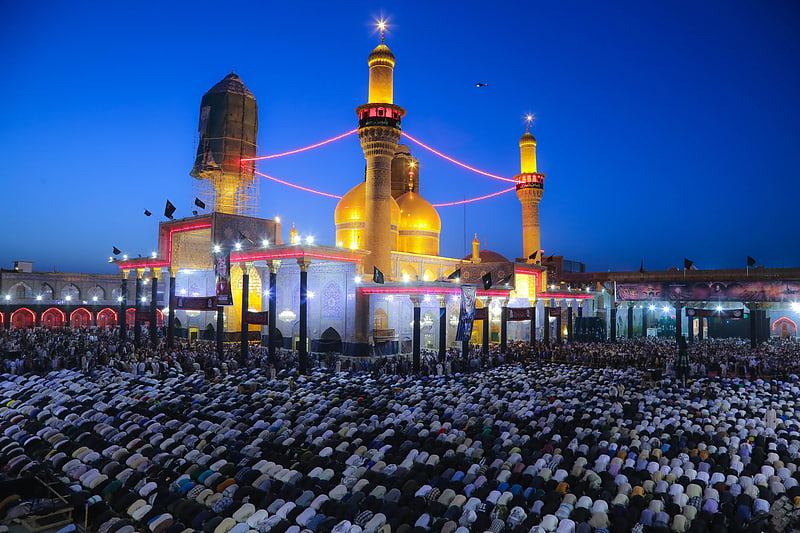
Also known as: العتبة الكاظمية
Mosque in Baghdad, Iraq. Al-Kadhimiya Mosque or Al-Kadhimayn Shrine is a Shi'ite Islamic mosque and shrine located in the Kādhimayn suburb of Baghdad, Iraq. It contains the tombs of the seventh and ninth Twelver Shī'ī Imāms, respectively Mūsā al-Kāẓim and his grandson Muhammad al-Jawad. Also buried within the premises of this mosque are the historical scholars Shaykh Mufīd and Shaykh Naṣīr ad-Dīn aṭ-Ṭūsi. Directly adjacent to the mosque are two smaller shrines, belonging to the brothers Sayyid Raḍī and Sayyid Murtadā.[5]
Address: Al-Kadhimiya Mosque, 10001 Baghdad (الكاظمية)
Al-Faw Palace, Baghdad
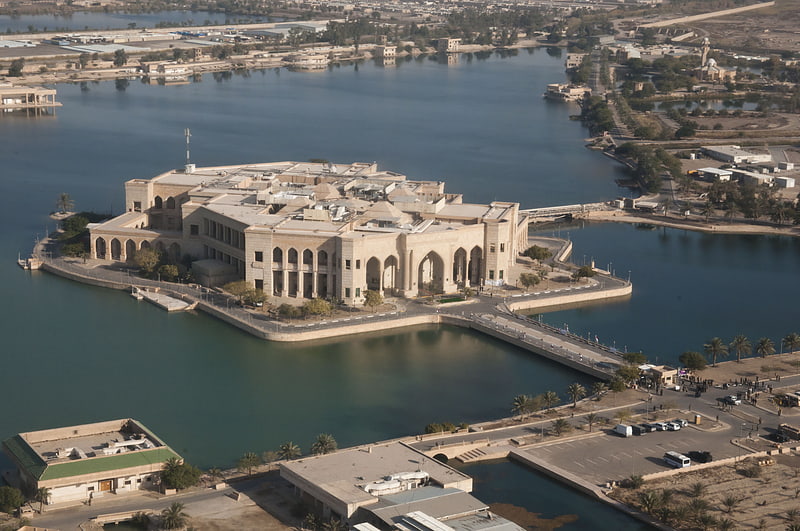
Also known as: قصر الفاو
Palace in Baghdad, Iraq. The Al Faw Palace is located in Baghdad approximately 5 km from the Baghdad International Airport, Iraq. Saddam Hussein commissioned its construction in the 1990s to commemorate the Iraqi forces' re-taking of the Al-Faw Peninsula during the Iran-Iraq conflict.[6]
Imam Husayn Shrine, Karbala

Also known as: العتبة الحسينية
Mosque in Karbala, Iraq. The Imam Husayn Shrine or the Place of Imam Husayn ibn Ali is the mosque and burial site of Husayn ibn Ali, the third Imam of Islam, in the city of Karbala, Iraq. It stands on the site of the Mausoleum of Husayn, who was a grandson of Muhammad, near the place where he was martyred during the Battle of Karbala in 680 CE The tomb of Husayn is one of the holiest places in Islam, outside of Mecca and Medina, and many make pilgrimages to the site. Every year, millions of pilgrims visit the city to observe Ashura, which marks the commemoration of Husayn's death. Every year for Arba'een rituals that occurs forty days after the Day of Ashura up to 45 million people go to the city of Karbala.[7]
Address: Sharii Al-Qibla, 56001 Karbala
Al Abbas Mosque, Karbala
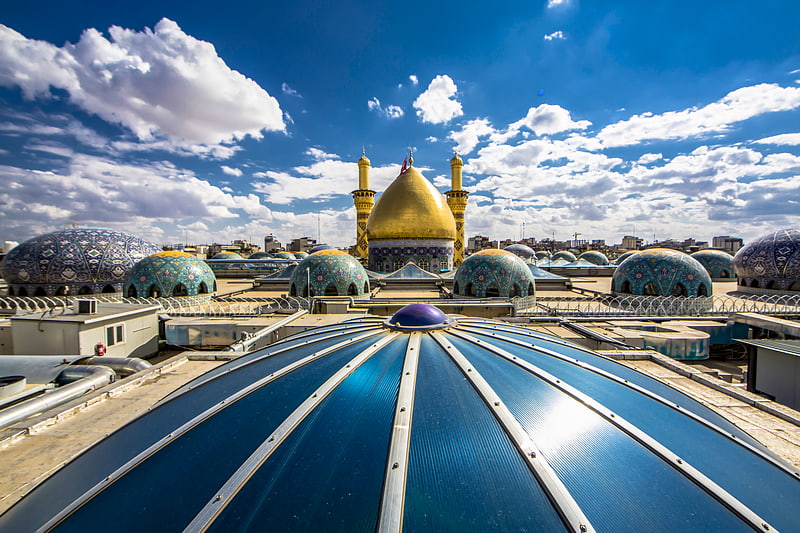
Also known as: العتبة العباسية
Mosque in Iraq. The Al-Abbas Shrine is the mausoleum of Abbas ibn Ali and a mosque, located near the Imam Husayn Mosque in Karbala, Iraq. Abbas was son of Ali ibn Abi Talib and the half-brother of Imam Hasan and Imam Husayn. He was Husayn's flag-bearer in the Battle of Karbala and chief of his caravans. The shrine is especially revered by the Shia who visit it every year, in the month of Muharram rather than various other times of the year.
Environmental effects over the years have caused the Euphrates river to change course. Nearly 1,400 years after the Battle of Karbala, the river flows across the grave of Abbas and encircles it. It is said that the Euphrates has come to ‘Abbās now.
In recent years the shrine has undergone a series of enhancements and additions, such as the re-gilding of the dome, and more recently covering the former courtyard with a roof to accommodate pilgrims better. Each year the shrine is visited by millions of pilgrims coming from all over the world.[8]
Monastery of Saint Elijah, Mosul
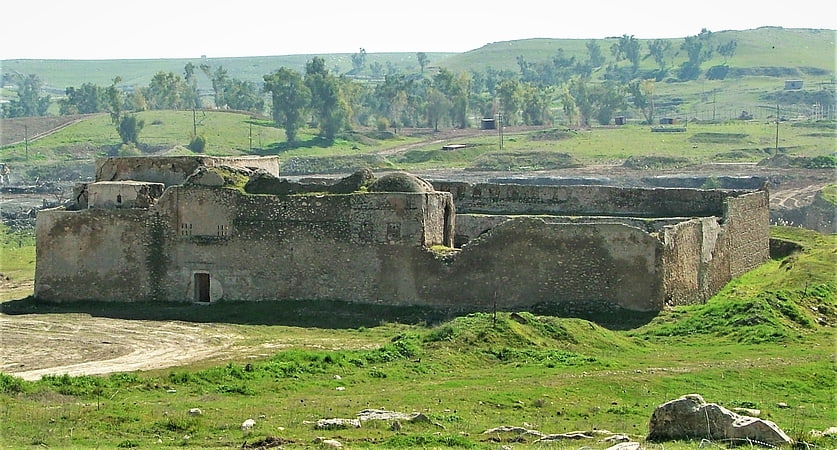
Monastery in Mosul, Iraq. Dair Mar Elia, also known as Saint Elijah's Monastery, was a Christian monastery located just south of Mosul, in the Nineveh Governorate, Iraq. It was founded in the late 6th century, and it was one of the oldest monasteries in Iraq. It belonged to the Church of the East, an ancient branch of Eastern Christianity, and then to the Chaldean Catholic Church. The monastery closed in 1743, after its monks were massacred by Persian forces. Its ruins were damaged during the invasion of Iraq in 2003, and were later demolished by the Islamic State of Iraq and the Levant in 2014.[9]
Imam Ali Mosque, Najaf
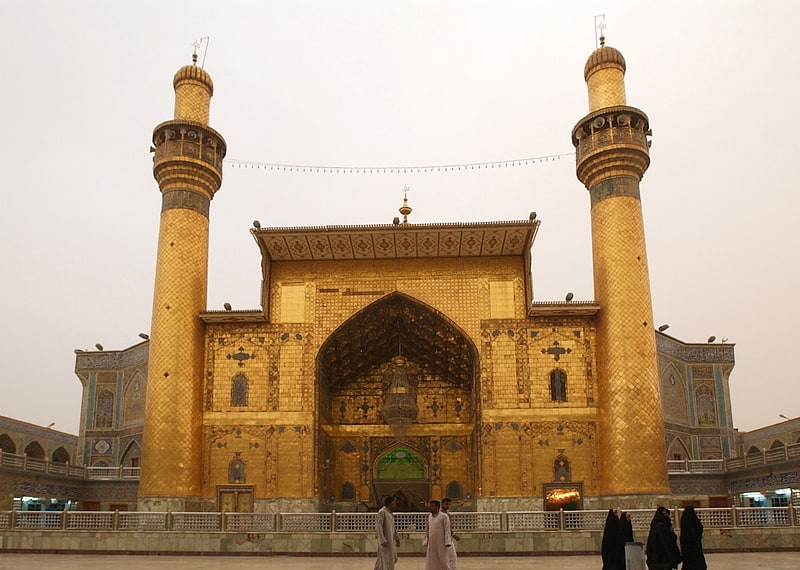
Also known as: العتبة العلوية
Mosque in Iraq. The Sanctuary of Imām 'Alī, also known as the Mosque of 'Alī, located in Najaf, Iraq, is a mosque which Shī'a Muslims believe contains the tomb of 'Alī ibn Abī Tālib. He was a cousin of the Islamic prophet Muhammad and later became his son-in-law. The Shī'as consider 'Alī as their first Imām, and the Sunnis regard him as the fourth Sunni Rashid Caliph. According to Shī'ite belief, buried next to 'Alī within this mosque are the remains of Adam and Nuh. Each year millions of pilgrims visit the Shrine and pay tribute to Imām 'Alī.[10]
Address: النجف الاشرف, Najaf
Nineveh, Mosul
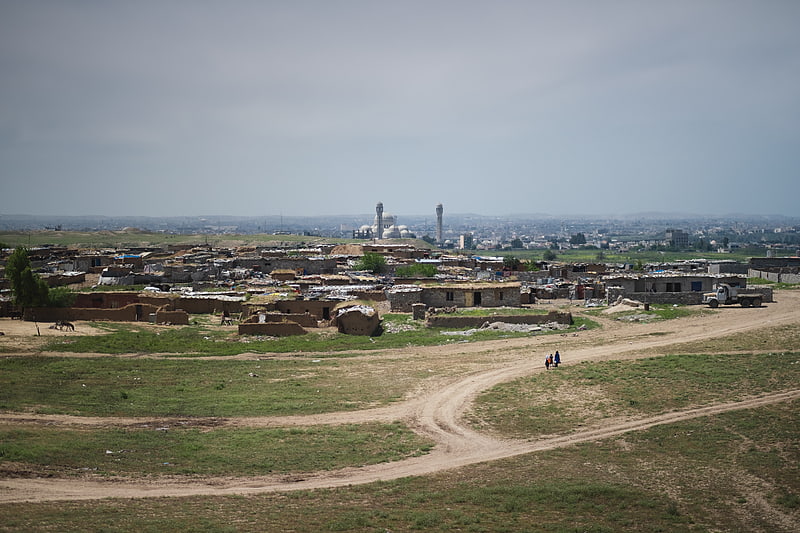
Also known as: نينوى
City in Iraq. Nineveh was an ancient Assyrian city of Upper Mesopotamia, located on the outskirts of Mosul in modern-day northern Iraq. It is located on the eastern bank of the Tigris River and was the capital and largest city of the Neo-Assyrian Empire, as well as the largest city in the world for several decades. Today, it is a common name for the half of Mosul that lies on the eastern bank of the Tigris, and the country's Nineveh Governorate takes its name from it.
It was the largest city in the world for approximately fifty years until the year 612 BC when, after a bitter period of civil war in Assyria, it was sacked by a coalition of its former subject peoples including the Babylonians, Medes, Persians, Scythians and Cimmerians. The city was never again a political or administrative centre, but by Late Antiquity it was the seat of a Christian bishop. It declined relative to Mosul during the Middle Ages and was mostly abandoned by the 13th century AD.
Its ruins lie across the river from the modern-day major city of Mosul, in Iraq's Nineveh Governorate. The two main tells, or mound-ruins, within the walls are Tell Kuyunjiq and Tell Nabī Yūnus, site of a shrine to Jonah, the prophet who preached to Nineveh. Large amounts of Assyrian sculpture and other artifacts have been excavated there, and are now located in museums around the world.[11]
Mosul Museum, Mosul
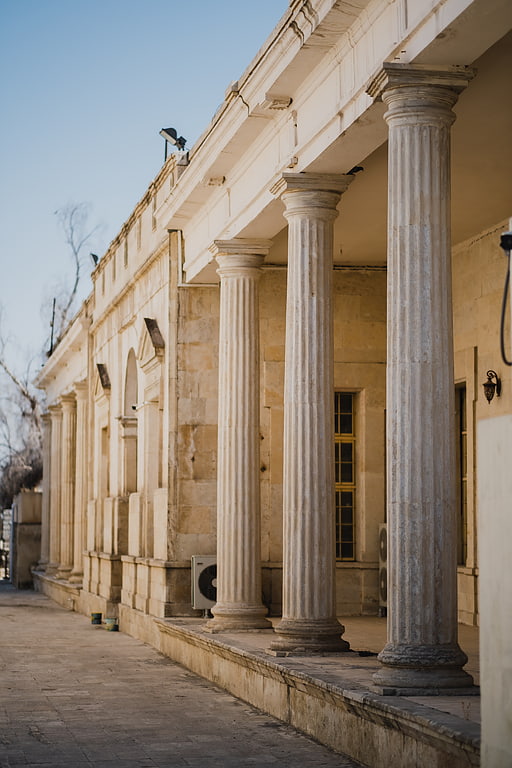
Also known as: متحف الموصل
Museum in Mosul, Iraq. The Mosul Museum is the second largest museum in Iraq after the National Museum of Iraq in Baghdad. It was heavily looted during the 2003 Iraq War. Founded in 1952, the museum consisted of a small hall until a new building was opened in 1972, containing ancient Assyrian artifacts. The museums net worth and content value are around 50 to 80 to 250 million according to museum specialists during 2013 at least. Dr. Hikmat Al-Aswad was the Director from 2004-2011. The current director is Zaid Ghazi Saadallah.[12]
Bayn al-Haramayn, Karbala
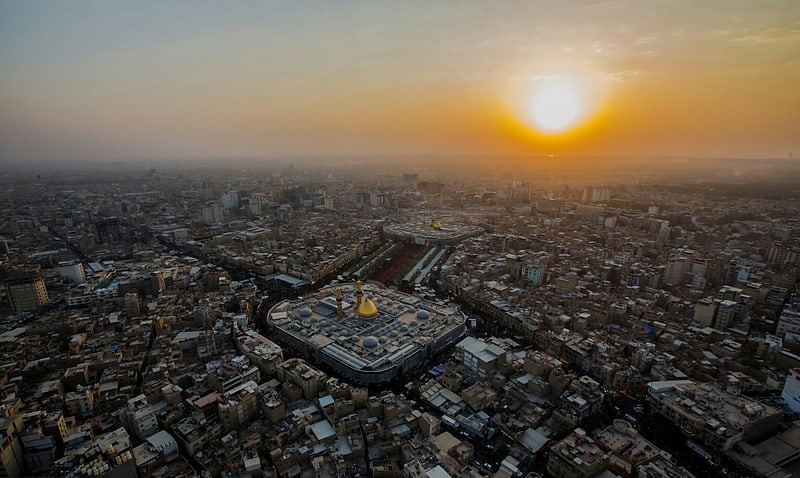
Bayn al-Haramayn, also transliterated as Bainul Haramain, is the area between the Imam Husayn Shrine and al-Abbas Shrine, which is a distance of 378 meters. It is said to be the exact place where the fighting in the Battle of Karbala took place.
In the past, the area was not an empty space between the two shrines; rather it was divided into a single main street and a number of alleyways, with residential and commercial buildings. During the Baathist era, the buildings between the two shrines were destroyed, and the area known today as Bayn al-Haramayn was formed. After the 2003 invasion of Iraq, the administration of the two shrines initiated a project of further developing the area, as well as the shrines to form a large unified precinct for the holy shrines of Karbala.[13]
Great Mosque of Kufa, Najaf

Also known as: مسجد الكوفة
Mosque in Kufa, Iraq. The Great Mosque of Kufa, or Masjid al-Kufa, is located in Kufa, Iraq and is one of the earliest and holiest surviving mosques in the world. The mosque, built in the 7th century, was home to Ali ibn Abi Talib, the 4th Rashidun caliph; and contains the holy shrine of Muslim ibn Aqeel, his companion Hani ibn Urwa; and the revolutionary, Al-Mukhtar. In recent history, the mosque has seen numerous renovations by Dawoodi Bohra.[14]
Al-Sahlah Mosque, Najaf
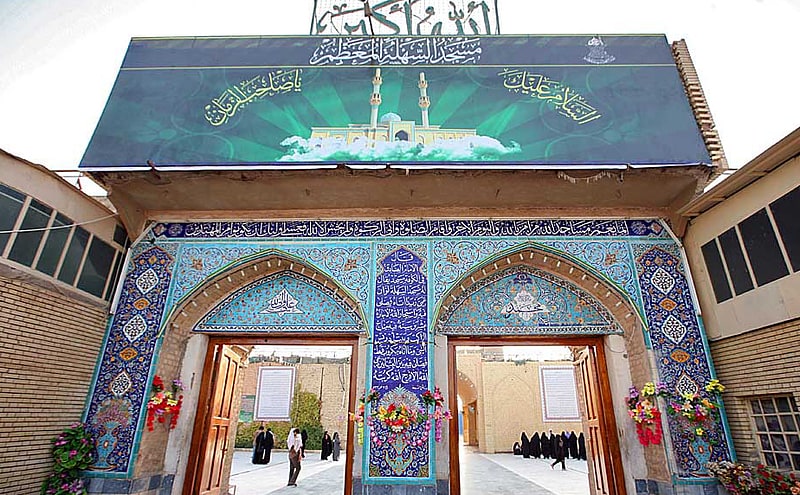
Also known as: مسجد السهلة
Mosque in Kufa, Iraq. The Al-Sahlah Mosque is one of the primary significant mosques in the city of Kufa, Iraq. The mosque is of great importance to Shia Muslims, and it is believed that the mosque was initially established in Kufa as a neighborhood mosque for the followers of Ali, the early members of the Shia. The mosque is also said to be the future home of the Twelfth Shia Imam, Hujjat-Allah al-Mahdi.[15]